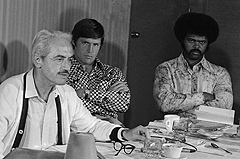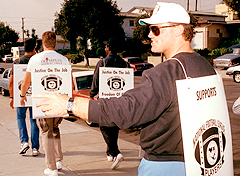Sports Unions Work to Level the Playing Field
June 30, 2009
Although their average salary is considerably higher and their “work year” is much shorter, members of the nation’s four major sports unions share much in common with their counterparts in other industries, especially the historical basis for their creation: Poor wages and unfair working conditions.
The Brotherhood of Professional Base Ball Players, America’s first professional-sports trade union, had a short and curious life that began in 1885 when eight National League players formed the Brotherhood in hopes of gaining higher wages. After failing as a labor union, the organization found investors and created a new league where players shared in “the gate.”
By the end of a single season as an “independent” league, however, team owners had soured on the profit-sharing system and sold the teams to ownership groups in the established rival league: Most of the players ended up with their former bosses.
Baseball Came First
It took more than 60 years after that failure to establish a sports union. The Major League Baseball Players Association traces its roots to 1953: The game’s “stars” were well compensated, but most of them held off-season jobs, as did all the rest of the players who had families to support. 
Players were like any workers: Baseball was their “job,” and they wanted security — higher wages, a pension plan, pay when they were unable to perform due to an injury sustained on the job, and compensation for extra work such as exhibition games.
Modern-day labor relations in sports is often pegged to 1966,when the MLBPA hired as its executive director Marvin Miller, the chief negotiator for the United Steel Workers. By 1968, Miller had negotiated the first players’ collective bargaining agreement, which nearly doubled the decade-old minimum salary (to $10,000) and included arbitration, which Miller considers the early union’s greatest achievement.
In 1972, after the first player strike in American sports history that resulted in the cancellation of games, the MLBPA secured professional athletes’ first significant pension benefits.
More significant player strikes occurred in midseason 1981, which wiped out about one-third of the regular season, and in 1994, which eliminated the last 50 games, and the entire postseason.
A contract signed in 1995 was good through 2003, and two successor contracts (running now through the 2011 season) have been negotiated since then.
The NFL
The National Football League was established in 1920, and saw its first organized labor activity in 1956, with the creation of the NFL Players Association.
A group of players requested a minimum $5,000 a year salary, per diem pay, a rule requiring clubs to pay for players’ equipment, and a provision for the continued payment of salaries to injured players. The union was essentially ignored by management until 1957, when a lawsuit over a player who wanted to be traded led to a Supreme Court ruling that prompted the owners to swiftly grant many of the players’ demands. 
In 1968, not long after the 16-team NFL and the 10- team American Football League had merged, the NFL players threatened to strike over the still-meager pension plan. Owners responding by locking the players out of training camp for a week; the NFL players then staged a brief strike.
Although the work stoppages are credited with leading to the first collective bargaining agreement for football players, the contract itself called for far less than the NFLPA had hoped to achieve: The minimum salary remained at $9,000 for rookies and $10,000 for veterans, and the league commissioner was still the arbitrator. But the AFL players signed on, and the NFL players thus had little choice.
In 1970, after the initial NFL collective bargaining agreement had expired, the players, now united, briefly struck during the preseason. But the first of two NFL strikes to result in cancelled games didn’t occur until more than a decade later, after Week 2 of the 1982 season. The players then stayed out for 57 days and came back to finish out an abbreviated season of nine games, with an expanded number of teams taking part in the postseason.
That four-year contract expired after the 1987 Super Bowl. The players struck the following September, with two games already in the books. Then there were three weeks of games featuring “replacement players,” followed by a week of cancellations. The end result was a one-game shortened (from 16 to 15) regular season and a postseason played on the regular schedule.
The most recent NFL-NFLPA agreement was signed in 1993 and has been extended three times – it now runs through the April 2010 college-player draft. The owners have the right to lock out the players if a settlement isn’t reached by then. Some observers feel that the 2010 season is in jeopardy.
The NBA
The National Basketball Association began in the late 1940s. In 1954, Bob Cousy of the Boston Celtics organized players and became the first president of the NBA Players Association. The NBA, paying average salaries of $8,000, basically ignored the NBPA, which also sought a per diem, healthcare benefits, and a pension plan.
Within a few years, there were discussions, but no real negotiations, and though the average salary inched up (by 1958, it was $12,000), there was no formal union recognition until 1964,when the players threatened to boycott the All-Star Game, which was the first in league history to be televised.
In 1970, after the expiration of the league’s first-ever labor agreement, players launched an antitrust lawsuit aimed at ending restrictions to free agency and, in 1976, players and owners signed a landmark agreement that eliminated clauses that bound players to their teams after their contracts had expired. Filed while superstar Oscar Robertson was president of the union, the successful suit resulted in what became known as “The Robertson Rule.” Twelve years later, the NBPA won a lawsuit that brought true, unrestricted free agency to players — a first for any major professional sports league.
The NBA suffered game cancellations for the first and only time just before the 1998-99 season was to start, when owners locked out the players. An agreement reached in January 1999 (no games in the “1998-1999 NBA Season” were played in 1998) ended the NBA’s only work-stoppage and resulted in a 50-game season and a by-the-book playoff scenario.
The NHL
The National Hockey League was formed in 1917. Although they play in the second-oldest of the major sports leagues, the NHL Players ’Association is the youngest of the four unions, dating to June 1967.
In popularity, the NHL has always run a distant fourth to football, baseball, and basketball in the U.S. But because most of its players were from Canada, the early NHLPA was able to demand that the owners recognize the new union or it would seek official recognition from the traditionally union-friendly Canadian Labour Relations Board.
Despite union recognition and advances in salary, pension, and healthcare matters, the players and management did not begin formal negotiations on a collective bargaining agreement until 1975. A first agreement, of five years’ duration, was signed in 1976.
The NHL players have never gone on strike, but they have been through two work stoppages, the first being a 103-day lockout just before the 1994-95 season, that shortened the season to 48 games (rather than 82).More recently, a lockout of NHL players that began just before preseason training camps were to open, resulted in the cancellation of the entire 2004-05 season.
An agreement that put the NHL back in business was reached after 310 days, on July 13, 2005. Although players received service credit toward their pensions and retirement, they lost an entire year’s salary. And all existing player contracts were subject to a 24 percent rollback. For example, a player who would have been paid $5 million in 2005-06, instead was paid $3.8 million.
Nonetheless, the agreement is being credited with saving the NHL from extinction, and thus saving the players their jobs.



